Ramblings on the Printed Rulebooks
It's time once again for ramblings about a seemingly random issue that might not be that important, but which has been living rent-free in my vacuous noggin for a while now and which I hope to exorcise by sharing it with unsuspecting readers (like an online version of The Ring ![]() ). The issue is the format of printed rulebooks; and while my thoughts apply to rulebooks for tabletop miniature wargames (or, as Mike Hutchinson and Glenn Ford suggest in The Fundamentals of Tabletop Miniatures Game Design: A Designer's Handbook (which I highly recommend), 'non-discrete miniatures games'), here I am focused solely on the rulebooks for the games of the Warhammer 40,000 setting. I don't presume to tell anyone "how it should be" in this post. After all, preferences for types of bookbinding are decidedly subjective. Rather, I am here to discuss my thoughts and personal preferences on the subject. I get a bit wish-listy at the end, burdened with the conviction that Games Workshop will never follow the path I suggest. If I don't get this off my chest, though, I'm likely to perseverate on the issue until I become a gibbering old fool (I'm halfway there
). The issue is the format of printed rulebooks; and while my thoughts apply to rulebooks for tabletop miniature wargames (or, as Mike Hutchinson and Glenn Ford suggest in The Fundamentals of Tabletop Miniatures Game Design: A Designer's Handbook (which I highly recommend), 'non-discrete miniatures games'), here I am focused solely on the rulebooks for the games of the Warhammer 40,000 setting. I don't presume to tell anyone "how it should be" in this post. After all, preferences for types of bookbinding are decidedly subjective. Rather, I am here to discuss my thoughts and personal preferences on the subject. I get a bit wish-listy at the end, burdened with the conviction that Games Workshop will never follow the path I suggest. If I don't get this off my chest, though, I'm likely to perseverate on the issue until I become a gibbering old fool (I'm halfway there ![]() ).
).
Note that I am only concerned with physical printed books. Yes, I know that digital rule[book]s are great and have many benefits. Games Workshop, however, has decided (almost certainly as the result of considerable evidence and analysis) that digital rules don't support their business model (i.e., their finances) and the closest they come to digital rules is the application that is [only?] available by subscription. And being a bit long in the tooth and with arms too short to hold my printed books where I can read them and their annoyingly small print without the aid of reading glasses, as well as being both a Luddite and a grognard, I want my rules to be printed. On paper. Back in my day we used to walk to the game store barefoot, uphill, in the snow, both ways, dagnabbit!
So what, exactly, is wrong with the current crop of rulebooks? After all, they are chock full of informative and entertaining content, evocative artwork, beautifully painted miniatures and terrain, and loads and loads of rules and background. I treasure my collection of over-sized hardback Forge World Imperial Armour and Horus Heresy rulebooks, after all. Compared to my 1986 copy of Fortress America (yes, I'm bragging), the modern books for Warhammer 40,000 are works of art. The Fortress America rules were nice at the time, but they were a bit Spartan by modern standards. If "Fortress America" isn't ringing any bells, or if you immediately think of the more recent version from Fantasy Flight Games, you can see an image of that saddle-stitched rulebook at the Board Game Geek here (that's it in the lower left of the image). So what do I have to complain about? Lots of things, I suppose, but I suppose I can narrow things down to four basic issues:
- Small print = difficult to read
- High production value = expensive
- Regular editions revisions = regularly replaced/re-purchased
- Physical usability (ergonomics?)
If you're young, you probably don't understand the first issue. Your young eyes can read the tiny letters just fine. Don't worry, one day you'll get old (hopefully), your eyes won't be as keen as those of the yungins, and your arms won't be long enough to hold the books where you can read them without the aid of spectacles. As embarrassing as it is to admit, I wish more rulebooks were in larger print. I have reading glasses scattered around my house and in my car, and it isn't uncommon for me to take a magnifying glass or my optivisor to gaming events (and I feel silly wearing them, but I need to read the rules, dangit!). No, I don't have either cataracts or glaucoma (yet).
Either I try to read the rulebook without some sort of magnification...

...or I suck it up and use some sort of magnification...
...either way, it's not pretty.
High production value is a different issue altogether, as it's generally a good thing. The various rulebooks for Warhammer 40,000 are beautiful, with lots of great artwork and content. They can be a pleasure just to look through. Even though rulebooks and codices from previous editions are now obsolete, I occasionally find myself reading them for simple enjoyment. Yes, I'm often researching things to cite obscure facts or the evolution of various aspects of the background, but there's no denying that these books look great. All of the hard work that goes into producing the content (writing and artwork) for these books, laying them out, and then actually printing them means that they're expensive, however. Don't get me wrong - everyone who has anything to do with creating these books deserves to be compensated. After all, we want them to continue doing great work, don't we? Sometimes, though, I wonder if we really need rulebooks with such high production values and costs. Would it be possible for Games Workshop to supply books that are of lower production value while remaining functional and attractive?
The cost of books with such high production values is magnified by having to replace them every few years (assuming we remain in the hobby for multiple editions, that is). I'm a bibliophile (book snob) of sorts. I have more than a few high-value books in my library, including a first edition copy of T.E. Lawrence's Seven Pillars of Wisdom. When I want to read Seven Pillars of Wisdom, however, I have a mass market copy. That first edition copy stays on a high shelf and is only brought out on occasion when I want to show it off. If the publisher printed a new updated edition of Seven Pillars of Wisdom every three to five years, rendering my first edition copy obsolete and forcing me to pay more and more for each subsequent edition, I would get a bit miffed. Expensive limited editions are fine and all, but limiting consumers to just those expensive versions and not giving them a more economical alternative isn't really consumer-friendly, especially with a relatively short lifespan for each edition, planned obsolescence, and the attendant need to replace multiple books every few years. Sure, you can Oldhammer it, but that limits your playing options: you're not likely to drop into a local brick and mortar game store for an unscheduled pick-up game with a stranger following the Oldhammer route.
Usability of a book covers a broad range of aspects. The size of the print is one of those aspects, though it is important enough that I have called it out separately. Other usability aspects include things like the physical size of the book, the type of binding, and even the internal organization of the book. While all usability issues are important, I'm primarily focused on the physical size and the binding. I could touch on every aspect of usability, but that would stretch this blog entry out far beyond members' tolerance (it is already longer than most people like ![]() ).
).
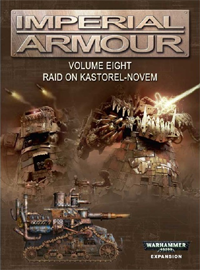 The physical size of a rulebook is expressed by its overall dimensions, including both the page size (e.g., 8.5 x 11 inches, A4, etc.) and the page count (i.e., the thickness of the book). Book thickness is also affected by the thickness/weight of the paper and the type of binding (binding will be addressed later). The book's dimensions will correlate with the amount of content and the size of the print. Two ways in which a book's size will affect players is in having to carry the book and in having a place for it during the playing of the game. The old Imperial Armour books, including the first edition of Aeronautica Imperialis and the Horus Heresy books, were about 9 x 12.25 inches (that's about 228 x 311 mm for those of you using a more logical system of measurement
The physical size of a rulebook is expressed by its overall dimensions, including both the page size (e.g., 8.5 x 11 inches, A4, etc.) and the page count (i.e., the thickness of the book). Book thickness is also affected by the thickness/weight of the paper and the type of binding (binding will be addressed later). The book's dimensions will correlate with the amount of content and the size of the print. Two ways in which a book's size will affect players is in having to carry the book and in having a place for it during the playing of the game. The old Imperial Armour books, including the first edition of Aeronautica Imperialis and the Horus Heresy books, were about 9 x 12.25 inches (that's about 228 x 311 mm for those of you using a more logical system of measurement ![]() ). Page count varied, but a heavier weight glossy paper was used, making the pages thick and durable. These were (are!) beautiful books, but they were heavy and required a lot of space. For many players, table space is often limited. In addition, the Warhammer 40,000 hobby often requires that players have multiple books to play the game, including the main rulebook, an army's codex, plus additional books such as campaign books and additional rules (which role the Imperial Armour books typically performed).
). Page count varied, but a heavier weight glossy paper was used, making the pages thick and durable. These were (are!) beautiful books, but they were heavy and required a lot of space. For many players, table space is often limited. In addition, the Warhammer 40,000 hobby often requires that players have multiple books to play the game, including the main rulebook, an army's codex, plus additional books such as campaign books and additional rules (which role the Imperial Armour books typically performed).
:strip_icc()/pic6026197.jpg) In contrast, many rulebooks come in smaller sizes. A common smaller size is A5 (5.83 x 8.27 inches or 148 x 210 mm). A great example of this is the first edition of the Barons' War game (which I love). This is a very handy compact size for storage and carrying. When a large amount of content is published in a smaller size, however, a balance has to be made between the print size, the margins, and any tables and charts that are presented in the book. Many players of the Barons' War game, including me, printed the rulebook at a larger size to facilitate reading and visibility (I spent quite a bit of money to have the main rulebook and three expansions printed larger only to have the second edition of the game, printed at a larger size, announced a couple of weeks later
In contrast, many rulebooks come in smaller sizes. A common smaller size is A5 (5.83 x 8.27 inches or 148 x 210 mm). A great example of this is the first edition of the Barons' War game (which I love). This is a very handy compact size for storage and carrying. When a large amount of content is published in a smaller size, however, a balance has to be made between the print size, the margins, and any tables and charts that are presented in the book. Many players of the Barons' War game, including me, printed the rulebook at a larger size to facilitate reading and visibility (I spent quite a bit of money to have the main rulebook and three expansions printed larger only to have the second edition of the game, printed at a larger size, announced a couple of weeks later ![]() ).
).
Games Workshop's Warhammer 40,000 rulebooks tend to be printed at a middle size. Commonly, however, they are filled with lots of (great!) content, thickening the books. At various occasions in the past, Games Workshop has mitigated this by offering rules-only versions, reducing book dimensions in terms of either page size or page count. After all, it is rare that players need to consult the lore aspects of the rulebook while playing a game, so providing a rules-only version of some books improves book usability at that point of the hobby. Games Workshop has not been consistent in this practice, however. The fourth edition of the game, for example, had a "pocket edition" of the rulebook in paperback while the sixth edition of the game provided a similar rules-only version of the rulebook in hardback:
:strip_icc()/pic969332.jpg)
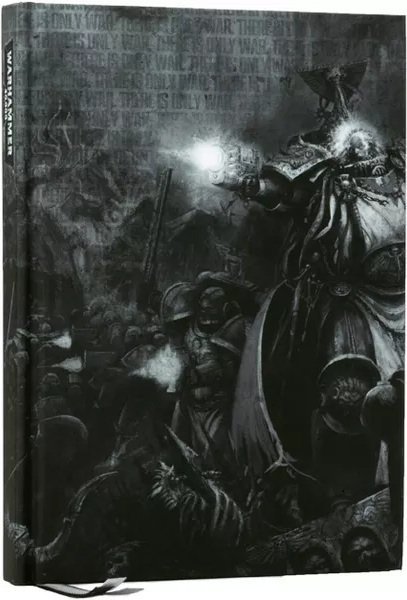
One of the things I really loved about the presentation of the seventh edition of the Warhammer 40,000 game was the separation of the rulebook into three separate volumes:
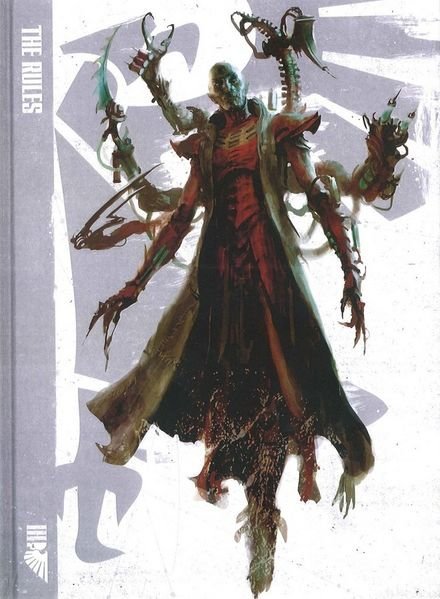
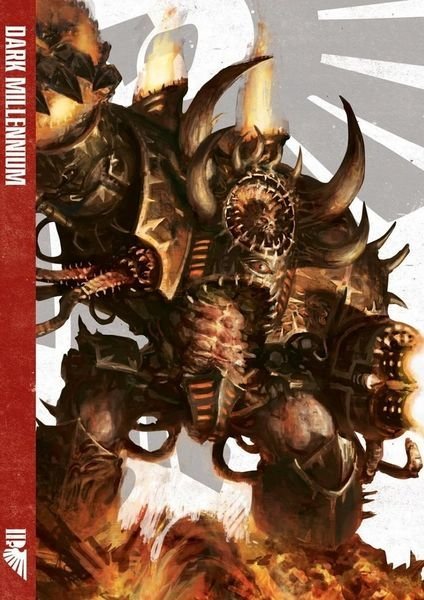
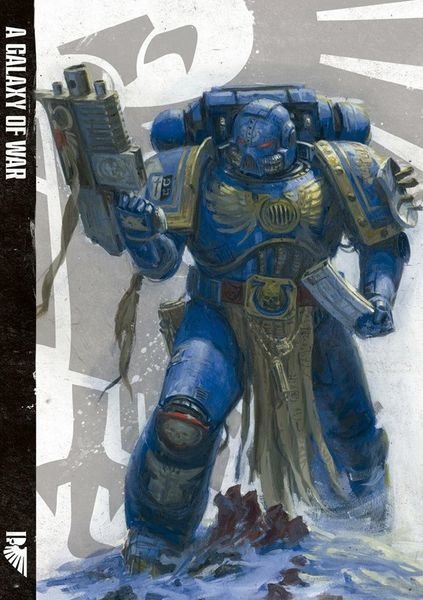
This probably wasn't everyone's cup of tea, but I quite liked it.
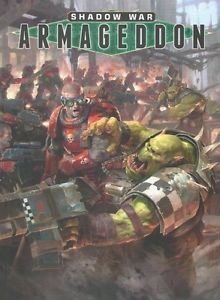 Another aspect of the rulebooks is the binding types. Back in the old days, when tabletop miniature wargames focused on historical settings (e.g., Napoleonics, World War II, etc.), rules were often printed in pamphlet style, usually saddle stitched. After all, the rulebooks focused almost solely on the rules since information on the settings were available in any number of other publications. As games grew to cover fantastical settings and the rulebooks began to include more content, and as the sophistication of hobbyists grew (debatable, I know
Another aspect of the rulebooks is the binding types. Back in the old days, when tabletop miniature wargames focused on historical settings (e.g., Napoleonics, World War II, etc.), rules were often printed in pamphlet style, usually saddle stitched. After all, the rulebooks focused almost solely on the rules since information on the settings were available in any number of other publications. As games grew to cover fantastical settings and the rulebooks began to include more content, and as the sophistication of hobbyists grew (debatable, I know ![]() ), rulebooks began to be published in larger perfect bound paperbacks and hardcover books. A not-uncommon problem with books presented in these formats, however, is that they sometimes don't stay open on the page that you want to read without being pressed by hand or by some device or weight. Worse, frequent use of these books and repeated pressing might crack the spine. This can be especially bad with some books, especially those that are perfect bound, when the glue cracks and some or all of the pages separate from the spine. A notorious example of this problem was the rulebook for the short-lived Shadow War: Armageddon game.
), rulebooks began to be published in larger perfect bound paperbacks and hardcover books. A not-uncommon problem with books presented in these formats, however, is that they sometimes don't stay open on the page that you want to read without being pressed by hand or by some device or weight. Worse, frequent use of these books and repeated pressing might crack the spine. This can be especially bad with some books, especially those that are perfect bound, when the glue cracks and some or all of the pages separate from the spine. A notorious example of this problem was the rulebook for the short-lived Shadow War: Armageddon game.
There are other types of binding that are more conducive to use such as rulebooks are put through during the course of gaming. Some examples include spiral, wire-o, and plastic comb bindings. Personally, spiral binding can look cheap, like a school notebook. Similarly, plastic comb binding also looks cheap and makes me think of books that are commonly distributed at conferences, seminars, and conventions. Of these three binding styles, I really prefer wire-o binding and its close relative, concealed wire-o binding. As with spiral binding, wire-o binding involves the pages of a book being held together by malleable wire. The double-wire of wire-o presents a better appearance than the single wire of spiral, however. With concealed wire-o binding, the wire is either wholly or partially concealed within the binding. An example of such binding is shown below:

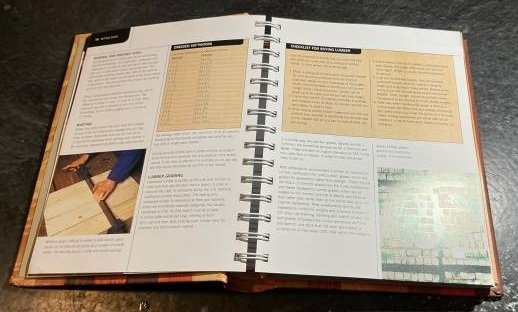
Not my pictures, but I have this book. Note how the book lays open right where you want it in the picture on the right.
As with any type of book binding, there are weaknesses with the alternatives I've mentioned. Beyond the cheap appearance, it's easier to rip pages out if you don't treat the book with respect (and flipping through pages quickly increases your chances of ripping one or more). If I'm going to have to replace a book every five (or fewer) years, however, I'd prefer to have to pay less for it.
It's important to realize that the "issues" that I've described above aren't confined solely to Warhammer 40,000 or Games Workshop. The Barons' War has been mentioned previously, but there was a famous (?) controversy over the Black Powder, Hail Caesar, and Pike & Shotte games from Warlord Games, as described in The Wargaming Compendium by Henry Hyde. Notably, many Warlord Games employees were former Games Workshop employees. Despite the controversy, subsequent expansions and the second editions of these games were published in similarly high-quality books. The grumblings of some members of the communities, whether Warhammer 40,000 or Black Powder, are rarely representative of the communities at large, and others either disagree with the conclusions of the grumblers or don't feel that those concerns are sufficient enough to prevent them from purchasing the books and enjoying the games.
And that, I think, is what this all comes down to: everyone has different opinions and preferences about what works for them. My opinion and preferences are just as worthless as everyone else's, I know.
Complaining without offering a solution is just whining, however, and I'm not a fan of that. So I'm willing to press on with a description of the alternative that I'd like to see. Realistically, I know full well that it's easy to be an armchair CEO, offering up ideas without an appreciation for the economics behind decisions. My perspective here is that of the consumer/hobbyist, with all of the limitations that entails. So it is entirely possible (likely, even) that some of my ideas wouldn't work as well as I like to think, whether because I am in the minority with regard to my own opinions/preferences or because the logistics behind making my ideas possible might be less cost-effective for Games Workshop. I'll press on anyways...
First, I like the model of the seventh edition of Warhammer 40,000, with the rules, setting, and hobby content separated into three separate volumes. And while those seventh edition books were available in the same slipcase and, therefore, of similar size in terms of paper size, it might be possible to make these books available in different sizes based on the needs and presentation of each. For example, the setting/lore and hobby books could be presented in larger sizes, allowing for enhanced appreciation of the imagery inherent in the former and improved detail necessary in the latter. A significant part of the hobby, after all, is its visual appeal; and having aesthetically attractive books that maximize that appeal can be extremely satisfying. Reading White Dwarf Magazine and other tabletop miniature wargame magazines scratches that itch; and a book I frequently look through is Masters in Miniature: Military History Recreated by Alan and Michael Perry (I'm a snob and shelled out extra for the signed copy). The rules book, meanwhile, might be smaller (though not too small), improving portability and reducing space requirements during game play. I would also love for the text to be a bit larger, making it easier for those of us with longer teeth and weaker eyes to read the rules. In addition, lifespans of the setting/lore and hobby books might be longer, only requiring updates when there are significant changes in their respective areas (e.g., the opening of the Great Rift, major range refreshes). This would decrease the amount of money that hobbyists have to spend on these aspects of the game. Meanwhile, the rules, whether the main rulebook, codices, or expansions/campaigns, would be the main focus of edition changes. With less content to update, it might be possible to accelerate the release of faction rules during an edition.
Second, I would prefer to see the rules presented in a lower budget format. Hear me out...
Some of you may have heard of Advanced Squad Leader. This is a chit and hex wargame, originally published by the Avalon Hill Game Company. Back in 1990, I purchased the rulebook for this game. It came as a three-ring binder. The binder was of a size that it was possible for players to add expansions within; and if a player ever collected more expansions than would fit within the binder (there are many expansions for ASL, after all), it was possible to purchase another [empty] ASL binder or to simply use some other binder. I'm not suggesting that such a binder necessarily needs to be a three-ring binder. It is not uncommon for planners to use six, seven, or more rings, and it's conceivable that a suitable option could be found. In addition, changes and updates might be made directly on the pages, either by writing them in or by printing up copies and taping/pasting them over the originally printed rules. Games Workshop did this with via the Chapter Approved books back in the third edition of the game. Alternately, changed pages might be made available as files that players could download and print, replacing the original pages. Instead of having to pay full price for a 1.5 rulebook, then, a player could simply download a small file with the changes (free would be better, but that might seem entitled) or purchase professionally printed replacement pages. Yes, a binder isn't nearly as sexy as a finely published book, but it's a lot cheaper. Moreover, players wouldn't need to lug around a bunch of books with rules scattered throughout - they could just carry a single binder with all of the necessary rules within.
A binder format is really only appropriate if Games Workshop plans to publish rules updates/errata in a way that hobbyists can print them and then replace obsolete pages. If Games Workshop doesn't follow that model, my preference would be for the concealed wire-o binding, especially since reference charts and the like can be included on gatefold covers (which might also be done with the binder option).
Third, for those who prefer high-quality books, Games Workshop might continue to provide those, either publishing them in smaller runs or by print-on-demand. This is a model that many other companies have used to good effect. Low-brow types like me might prefer the cheap and functional binder option, but there are wargaming connoisseurs/collectors who might want to have finely crafted books. For example, I purchased The Carmina Burana a few years ago and was pleased to see that it was print-on-demand (it was more expensive than a regular trade paperback might have been, but it was totally worth it).
You might not know the book, but you are probably familiar with the cantata, or a portion thereof,
that Carl Orff composed based on it. If the name doesn't ring a bell, click on the image (I'll wait here).
Games Workshop could still offer collectors' editions, too, making those truly special for collectors. These are worthwhile for some, but unnecessary for others.
Don't get me wrong, I'm not kidding myself about the prospects of Games Workshop shifting from its current model of high-quality, high-cost, frequently replaced books. This has all really been an exercise in "if I ran the zoo." Also, it's likely that many (most?) other hobbyists might disagree with me, finding the current model acceptable over the long term. There may be some who agree with me, but I suspect that those are in the minority.
What do you think of Games Workshop's current model regarding printed rulebooks? Is there some alternative model that you would prefer?
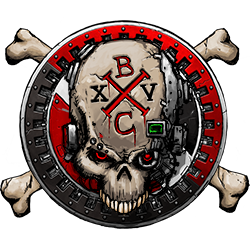




1 Comment
Recommended Comments
Create an account or sign in to comment
You need to be a member in order to leave a comment
Create an account
Sign up for a new account in our community. It's easy!
Register a new accountSign in
Already have an account? Sign in here.
Sign In Now